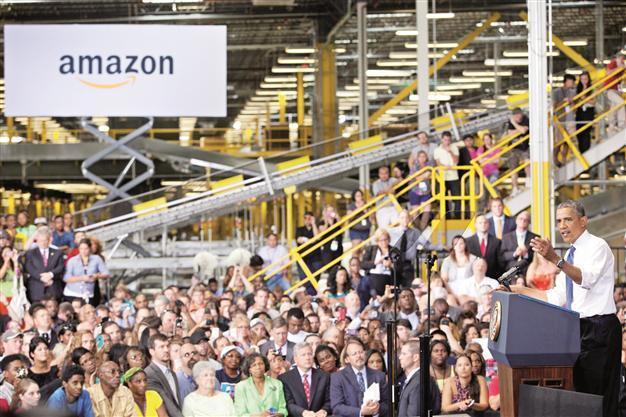US sees economic growth faster than expected in Q2
WASHINGTON - Reuters

US President Barack Obama makes a speech about the economy and jobs at an Amazon.com Fulfillment Center a day before announcement of GDP data. AFP Photo
U.S. economic growth unexpectedly accelerated in the second quarter, laying a firmer foundation for the rest of the year that could bring the Federal Reserve a step closer to cutting back its monetary stimulus.
Gross domestic product grew at a 1.7 percent annual rate, the Commerce Department said on July 31, stepping up from the first-quarter’s downwardly revised 1.1 percent expansion pace.
Economists polled by Reuters had forecast the economy growing at a 1.0 percent pace after a previously reported 1.8 percent advance in the first three months of the year.
A rebound in business spending, export growth and a sharp moderation in the pace of decline in government outlays boosted economic growth in the April-June period, offsetting a slowdown in consumer spending and a steady rate of inventory accumulation.
Still, the report marked a third straight quarter of GDP growth below 2 percent, a pace that normally would be too soft to bring down unemployment. But growth was poised to gain even more momentum in the second half of the year as the fiscal burden brought on by belt-tightening in Washington eases.
Dollar rallyThe strong data cause dollar to rally across the board on the expectations that the Federal Reserve will scale back its asset buying plan this year.
Federal Reserve officials, wrestling with a decision on the future of their $85 billion per month bond-buying program, will probably nod to the downward revision to first-quarter growth, but draw comfort from the pick-up in output last quarter, when they wind-up a two-day meeting on July 31.
Fed Chairman Ben Bernanke said last month that the central bank was likely to start curtailing the bond purchases later this year and would probably bring them to a complete halt by the middle of 2014, if the economy progressed as expected.
Adding to the better tenor of the report, comprehensive revisions to the data cast the economy in a better light than previously.
The government has implemented some changes in how it calculates GDP. For example, research and development spending will now be treated as investment, and defined benefit pension plans will be measured on an accrual basis, rather than as cash.
Economic growth was relatively stronger between 2009 and 2012 than previously reported. In fact, the economy grew 2.8 percent last year, 0.6 percentage points faster than the government had previously estimated.
The revisions also yielded a higher rate of savings, a good omen for consumer spending in the future.
Higher taxes, as Washington tries to shrink the government’s budget deficit, constrained consumer spending in the second quarter, keeping the economy on an anemic growth pace.
Consumer spending, which accounts for more than two-thirds of U.S. economic activity, slowed to a 1.8 percent growth pace after rising at a 2.3 percent rate in the first quarter.
With domestic demand tepid, businesses kept their inventories from bulging. Inventory accumulation added 0.41 percentage point, less than half the contribution from the prior quarter.
Other details of the report showed exports rebounded, showing the largest percentage gain since the third quarter of 2011, even as demand weakened in Europe and China.
But the increase was not enough to offset a rise in imports, leaving a trade deficit that weighed on growth.
